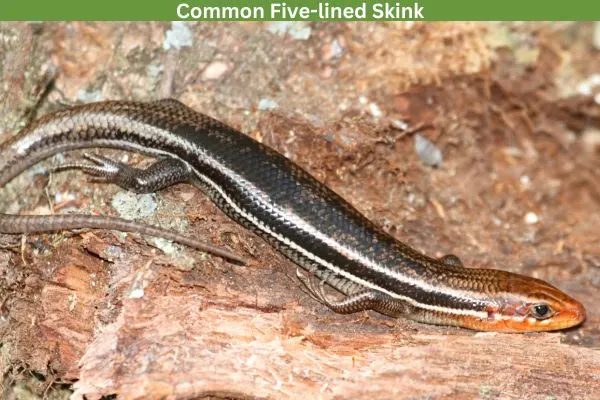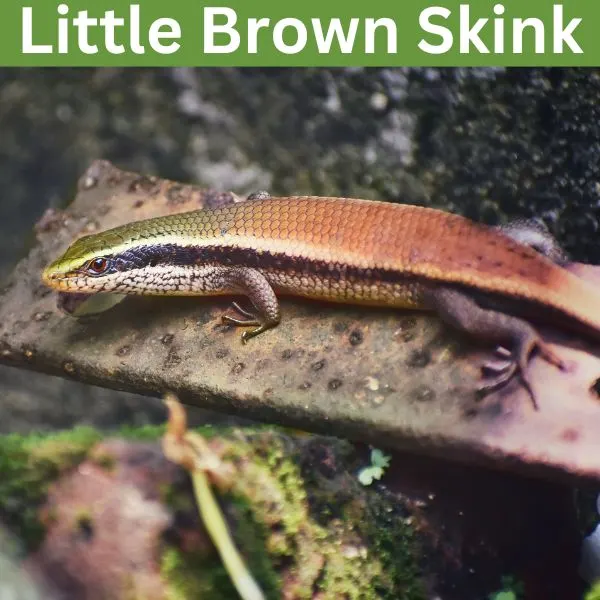New Jersey is home to around 5 lizard species, with two of them being invasive to the state. Lizards are important animals in their ecosystem, and while small they help balance out their environment. Lizards also can make a good pet with the right species, and owner.
Here we will take a look at all the lizards you may find in New Jersey, and useful things to know about them that may make it easier to find them in the wild. Some of the things that help identify lizards include their color, scales, size, and location where they are found.
Learning about lizards is not only fun, but helps you discover how important animals are in their overall environment. Many of the animals like lizards in New Jersey are being affected by population decline due to humans. Maintaining their New Jerseys natural habitats not only protects the state’s beauty, but also lets species maintain their strength.
Table of Contents
Lizards in New Jersey
1. Common Five-lined Skink

- Experience Level: Intermediate
- Family: Scincidae
- Scientific Name: Plestiodon fasciatus
- Other Names: American Five-lined Skink
- Adult Size: 4.9 to 8.5 in. (12.5 to 21.5 cm)
- Lifespan: 6 years
- Average Price Range: $12
Native to the eastern United States, the common five-lined skink is one of the two types of skink lizards that live in New Jersey. These lizards are found in all of New Jersey, living in partially wooded, and rocky habitats. Urban areas are a common area to find this lizard, and they are sometimes seen near abandoned buildings.
Common five-lined skinks get their name from the five lines that run down their back, which are beige, or yellow. They have a black, olive, or tan coloring, with a blue tail when young. These skinks are medium, and their colors fade to be more dull as they age.
If attacked this lizard can drop its tail, but prefers to flee, and hide first. They feed on insects, and other small invertebrates. This species is one of the most common lizards in New Jersey, and can be seen throughout the state.
2. Little Brown Skink

- Experience Level: Beginner
- Family: Scincidae
- Scientific Name: Scincella lateralis
- Other Names: Ground Skink, Brown-backed Skink
- Adult Size: 3 to 5.25 in. (7.62 to 13.3 cm.)
- Lifespan: 2.5 years
- Average Price Range: $5
Little brown skinks are a small, slender species, named after their coppery, or tan coloring. They have small limbs, with a long tail, and a small head. Their bodies have a dark stripe that appears on their side, with specks covering them.
In moist woodlands, or wetland habitats are common places this skink lives. They are native to the south-eastern United States, and are found mainly in southern New Jersey. Little brown skinks are fossorial, and spend their time underground, or in leaf litter.
A very common lizard to find, this lizard preys on small insects, spiders, and isopods on the ground. They are active most from spring to fall, and hibernate in the winter. When mating in the spring they can lay up to 6 eggs, which hatch only a month later.
3. Eastern Fence Lizard

- Experience Level: Intermediate
- Family: Phrynosomatidae
- Scientific Name: Sceloporus undulatus
- Other Names: Northern fence lizard, gravid lizard, pine lizard
- Adult Size: 4 to 6 inches
- Lifespan: 5 to 7 years
- Average Price Range: $20
Eastern fence lizards have a large range in the southeastern United States. These lizards are native to New Jersey, and live within the southern portion of the state. Eastern fence lizards live in woodlands, shrublands, grasslands, and urban habitats. They are common in areas with lots of trees, and enjoy climbing on structures like fences.
The scales of the eastern fence lizards are roughly keeled, and have a tan, or gray coloring. Females may have dark wavy markings that appear on their back, while males can have a plain appearance. Males of this species also have bright blue coloring on their underside.
Eastern fence lizards are very quick, and use their speed to run up walls, or trees. They are a sit-and-wait predator that feeds on small ants, beetles, and other similar prey. These lizards are very common, but may face predators like fire ants, birds, or larger lizards.
4. Italian Wall Lizard

- Experience Level: Beginner
- Family: Lacertidae
- Scientific Name: Podarcis siculus
- Other Names: Ruin lizard
- Adult Size: 3.5 in. (9 cm.)
- Lifespan: 13 years
- Average Price Range: n/a
The Italian wall lizard is one of the invasive lizards that live in New Jersey. These lizards are found in farmlands, grasslands, woodlands, and urban habitats. They are originally from the Italian Peninsula, but have been introduced to several regions around the world.
Italian wall lizards have a green, or brown body, with a white, or green belly. They are medium-sized, to larger lizards. Males of this species are slightly larger, and have bigger heads. Spots, bands, and blotches may appear on this lizard, and they have very small scales.
These lizards feed on beetles, moths, spiders, and other small invertebrates. They use chemical trails to track, and find prey. These lizards may compete with other lizards for food, or habitat, but are very rare in New Jersey.
5. Mediterranean House Geckos

- Experience Level: Beginners
- Family: Gekkonidae
- Scientific Name: Hemidactylus turcicus
- Other Names: Moon Lizard, Turkish Gecko
- Adult Size: 4 to 5 in. (10 to 13 cm.)
- Lifespan: 3 to 9 years
- Average Price Range: $10
Mediterranean house geckos are an invasive species found in New Jersey. They are mainly found in urban areas, like near houses, abandoned buildings, or warehouses. Mediterranean house geckos are native to the Mediterranean region, but have been transported to regions around the globe due to trade between countries.
These lizards are small, with a tan, to cream color. They have very bumpy skin, with dark markings on them. Pads appear on this lizard’s feet, which help them climb walls. These geckos have large yellow eyes, which give them great night vision.
Mediterranean house geckos are active at night, near light sources, and other areas with lots of food for them to eat. Insects make up the majority of this lizard’s diet, and in the day they will hide in a secluded crevice. The size, and where this lizard lives make them have very little effect on the regions they become invasive to.
FAQ
Are lizards common in New Jersey?
There are only 3 lizard species that are native to New Jersey. New Jersey has in total 71 species of amphibians, and reptiles to discover in the wild, and lizards are just a small portion of the region’s wilderness.
Where in New Jersey can I find lizards?
New Jersey’s habitats like woodlands, open forests, grasslands, and even urban areas are where lizard species live. While there are only a few lizard species that live in the state, you may come across them often in the right season.
Wrapping up
Lizards are very important animals despite their size, since they feed on pest animals like insects, or are used for food by things like birds. These reptiles may look very unique, and colorful, while others can be dull. Damp wetlands, and swamps make up the majority of habitats in New Jersey, which make it a perfect place for wildlife to flourish.
Due to the pet trade, and other common travel methods there may be new invasive lizards introduced to New Jersey in the future. The current ranges, and populations of lizards native to New Jersey may also change. It is essential to maintain the habitats that lizards live in, which also keeps the overall ecosystem healthier in New Jersey.
More lizards in nearby states
Table of Contents
